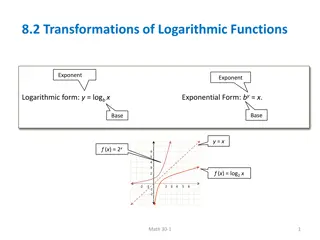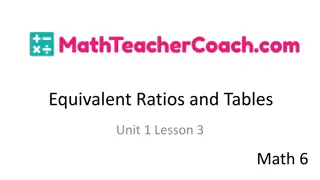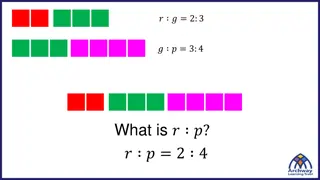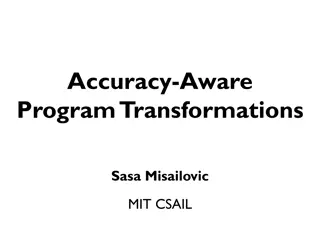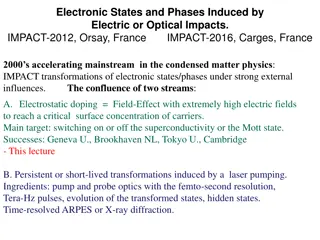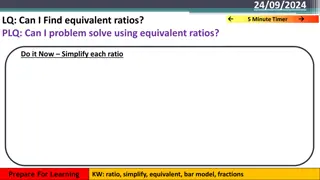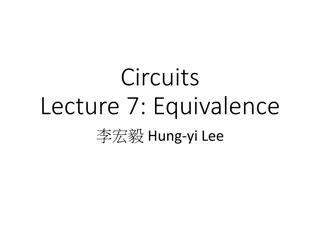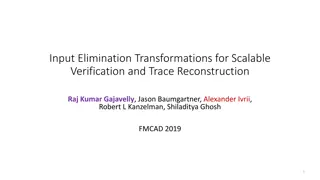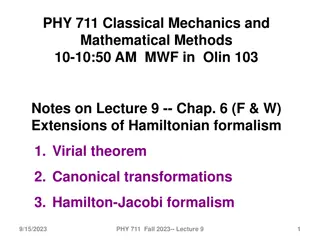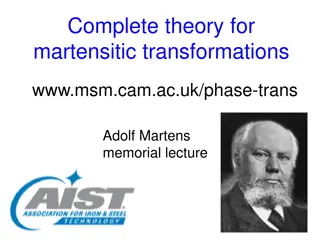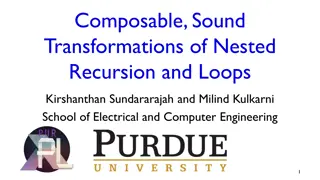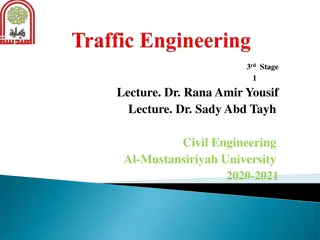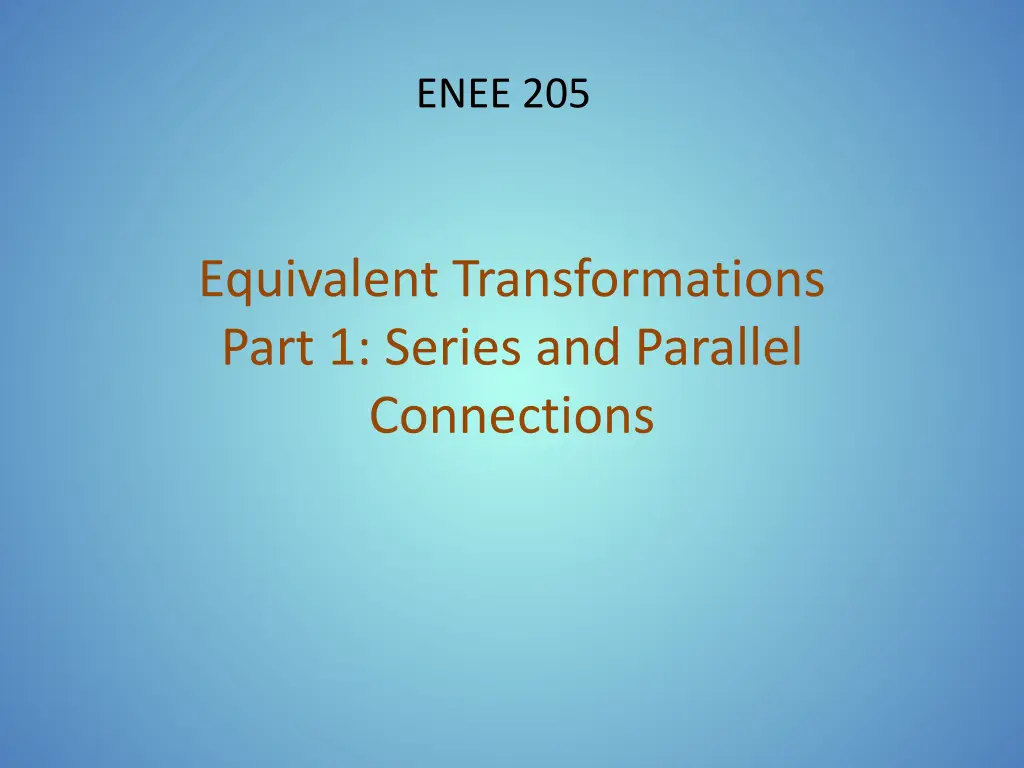
Understanding Equivalent Transformations in Electrical Circuits
Explore the concept of equivalent transformations in electrical circuits, focusing on series and parallel connections of passive components. Learn how to determine input impedance, analyze series and parallel connections, and understand the relationship between voltage and current in circuits. Dive into examples of series and parallel connections to enhance your understanding of circuit analysis.
Download Presentation

Please find below an Image/Link to download the presentation.
The content on the website is provided AS IS for your information and personal use only. It may not be sold, licensed, or shared on other websites without obtaining consent from the author. If you encounter any issues during the download, it is possible that the publisher has removed the file from their server.
You are allowed to download the files provided on this website for personal or commercial use, subject to the condition that they are used lawfully. All files are the property of their respective owners.
The content on the website is provided AS IS for your information and personal use only. It may not be sold, licensed, or shared on other websites without obtaining consent from the author.
E N D
Presentation Transcript
ENEE 205 Equivalent Transformations Part 1: Series and Parallel Connections
EQUIVALENT TRANSFORMATIONS AND INPUT IMPEDANCE Consider the two sub-circuits shown to the right. One circuit is said to be an equivalent transformation of the other if the relation between the voltage across the two terminals to the current entering the corresponding terminal is the same for the two sub-circuits. Claim: If a sub-circuit is comprised of only linear, passive components, that sub-circuit can be replaced under sinusoidal steady- state conditions by a single passive branch. If the replacement is done across the input terminals of the sub-circuit, the equivalent impedance is called the input impedance. I + V - Circuit A I + V - Circuit B
Series connections of passive components K COMPONENTS ARE SAID TO BE CONNECTED IN SERIES IF THEY ARE ALL CONNECTED TOGETHER BY TRIVIAL NODES. THUS, THEY ALWAYS SHARE THE SAME CURRENT! Z1 Z2 Zj I1 Ij I2 Ik + V1 - + V + Vk + V2 - + Vj - Zk - - KVL around the loop: ? + ?1+ ?2+ + ??+ + ??=0 KCLs: ?1= ?2= = ??= ?? ? Inserting Impedances: ? = ?1?1+ ?2?2+ + ???? Or ? = ?1? + ?2? + + ??? = ?1+ ?2+ + ??? Or ? ?= ?1+ ?2+ + ?? a single impedance would have ? ?=Zeq so Zeq = Z1 + Z2+ +Zj+ + Zk
Series connection examples Impedances add in series: Zeq = Z1 + Z2 + Z3+ + Zk Resistances add in series: Inductances add in series Voltage sources add in series
Parallel connections of passive components K COMPONENTS ARE SAID TO BE CONNECTED IN PARALLEL IF THEY ARE ALL CONNECTED TOGETHER BY TRIVIAL MESHES. THUS, THEY ALWAYS SHARE THE SAME VOLTAGE! I I1 I2 Ij Ik + V + V1 + V2 + Vj + Vk Yk Y1 Y2 Yj - - - - - KCL at lower node: ? + ?1+ ?2+ + ??+ + ??=0 KVLs: ?1= ?2= = ??= ??= ? Inserting Admittances: ? = ?1?1+ ?2?2+ + ???? Or ? = ?1? + ?2? + + ??? = ?1+ ?2+ + ??? Or ? ?= ?1+ ?2+ + ?? a single admittance would have ? ?=Yeq so Yeq = Y1 + Y2+ +Yj+ + Yk
Parallel connection examples Admittances add in parallel : Yeq = Y1 + Y2 + Y3+ + Yk Conductances add in parallel Capacitances add in parallel Current sources add in parallel 10 mA Ieq=30 mA 10 mA 10 mA
An R-2R ladder example R R R R R R R 2R 2R 2R 2R 2R 2R R R R R R R 2R 2R 2R 2R 2R R R R R R R 2R 2R 2R R 2R 2R
ENEE 205 Equivalent Transformations Part 2: Voltage and Current Divider Rules
VOLTAGE DIVIDER RULE Z2 I2 Z1 Zj I1 Ij Ik + V1 - + + Vk + V2 - + Vj - Zk Vin - - KVL around the loop: ???+ ?1+ ?2+ + ??+ + ??=0 KCLs: ?1= ?2= = ??= ?? ? Inserting Impedances: ???= ?1?1+ ?2?2+ + ???? Or ???= ?1? + ?2? + + ??? = ?1+ ?2+ + ??? ?? ???= Defining the input impedance ???= ?1+ ?2+ + ??, ??? ?? Since ??= ????= ???, ?1+?2+ +???= ?1+?2+ +?? V Z Z j j j = = k V Z = l Z in in l 1
VOLTAGE DIVIDER RULE analysis ? = 2 ???/? + ?? - 2 V(t)=100cos(2t) V ???= 100 ? + ?? - V Z Z 2j j j j = = k V Z = l Z + ?? - in in l -j 1 ?? ??? ?? 2 2 + Vout - = 100 ?= 2 + 2? ?= 2 + ? 2 ? ??= 200 (2 + ?)(2 ?)= 40 2 ? ? ???? 5000 ?= ????= 50 50 1000 425 + 425 + 100 + 50= 10005000= 250 ? ?? ??? ?? ? ? 2 + ? = 100 ?= 2 + 2? ?= 50 ??= 20 1 + 2? ?
CURRENT DIVIDER RULE I1 I2 Ij Ik + V + V1 + V2 + Vj + Vk Yk Iin Y1 Y2 Yj - - - - - KCL at lower node: ???+ ?1+ ?2+ + ??+ + ??=0 KVLs: ?1= ?2= = ??= ??= ? Inserting Admittances:???= ?1?1+ ?2?2+ + ???? Or ???= ?1? + ?2? + + ??? = ?1+ ?2+ + ??? ?? ???= Defining the input admittance ???= ?1+ ?2+ + ??, ??? ?? Since ??= ????= ???, so ?1+?2+ +???= ?1+?2+ +?? I Y Y j j j = = k I Y = l Y in in l 1
Current DIVIDER RULE analysis I Y Y j j j = = k I Y Iin = l Y in in Iout l 1 i(t)=100cos(2t) mA ? = 2 ???/? ???? ??? 1/300 1 300+ =1 = 1 1 3 300+ 300 2j -j/2 Iin Iout So ????= ???/3 ???? ??? =???? 0.1?= 2? ?/2=4 2? 3 So ????=4??? = 133 ?? = 0.133? 3
ENEE 205 Equivalent Transformations Part 3: Voltage and Current Divider Designs
Voltage divider DESIGN example Design a resistive voltage divider with a ratio of 1:1000 (output : input) and an input impedance of 1 M . ???? ??? ?1+ ?2 ???= ?1+ ?2= 1 M ?2 ?1+ ?2 ?2 1 = = 1000 + ?2 1 Vin = 1,000,000= + Vout - 1000 - So ?2= 1? ?1= 1 M ?2= 1? 1? ?? ?1 1?
Voltage divider DESIGN example Design a capacitive voltage divider with a ratio of 1:10000 (output : input) and an input impedance magnitude of 50 . The frequency is f = 100,000 Hz. ???? ??? 1/???1+ 1/???2 ??? =1 ? ?1 ?2 ?1?2 ?2+ ?1 ?1?2 ?2+ ?1 ?2= 3.183?10 4= 318?? ????? ?2 ?1 ?1 3.183?10 8= 31.8 ?? 1/???2 ?1 1 = = = ?2+ ?1 ?2+ ?1 ?1?2 10,000 1 +1 =1 + = 50 ? Vin 1 + Vout - 50 2? 100,000= 3.183?10 8 = - ?1 ?2 104 3.183?10 8= = ?2 = ?2+ ?1
Current divider DESIGN example Design a resistive current divider with a ratio of 1:100 (output : input) and an input impedance of 100 . ???? ??? 1/?1+ 1/?2 ???= ?2[?1/(?1+ ?2)] = 100 ?2 100= 100 ???2= 10 ? 1 +?2 ?1 ?1=?2 99= 101 1/?2 ?1 1 = = = ?1+ ?2 100 R2 ?? R1 = 100
ENEE 205 Equivalent Transformations Part 4: The Superposition Principle
SUPERPOSITION PRINCIPLE SUPERPOSITION ALGORITHM Start with a circuit that contains M sources. Divide the circuit into N sub-problems (often N=M, but that is not a necessary requirement.) Make sure each source is on in exactly one of the sub-problems Solve each sub-problem for the desired voltages and currents. Find the desired voltages and currents for the original problem by summing up the respective voltages and currents for each of the sub-problems. If you change reference directions for any of the sub-problems (not recommended, but possible), take that into account when summing the sub-problem results. NOTE: Superposition works because all the SSS equations are linear (no diodes!)
Setting a source to zero This is only done with independent sources. Dependent sources and passive components remain the same in each sub-problem. = = 0V 0A open short
3 bit D-to-A converter example R R R R R R 2R 2R 2R b1 b2 b0 Iout
Case (1) Original problem (1) ???? ???? (0) (2) ???? ???? Case (2) Case (0) (2)+???? (1)+???? (0) ????= ????
Case (2) R-2R ladder, so the equivalent resistance is 2R (2) ???? (2) ????
Case 2, continued The two outer 2R resistors are in parallel. By symmetry, those two resistors must have the same current going through them, so the battery B2 must be supplying 2iout. Recognizing the current coming out of the source allows one to combine the two outer resistors. Then, by using Ohm s Law: (2)=?2 3? ?? ???? (2)=?2 2???? 6? (2) 2???? (2) 2???? (2) (2) ???? ????
Case 2, the end If one were to solve for the other two cases, one would find: ???? ?1 12? and (1)+???? ?0 24? (1)= (0)= ???? (0)=4?2+2?1+?0 (2)+???? So that ????= ???? Which is an equation for a 3-bit Digital-to- Analog converter. 24?
ENEE 205 Equivalent Transformations Part 5: Op-amp Circuits with multiple input sources
Rf Inverting Summing Amplifier One can use superposition here. Let V1 be on and all other sources off. Then R2 through Rk are connected between the inverting and non-inverting terminals, and so have no voltage across them. - + Rk + Vk - R2 R1 + + V1 - + V2 - Vout Rf - Thus R2 through Rk also have no current through them and they can be removed form the circuit. What remains is a simple inverting amplifier, so (1)= ?1?1. - + Rk R2 R1 + + V1 - Vout ?? ???? -
Inverting summing amplifier Rf For Case (2), only V2 is on and all other voltages sources are replaced by shorts. R1 and R3 Rk have no current though them and can be removed. What remains is a simple inverting amplifier, so (2)= ?2?2. For each case, only one source will be on, and the final circuit will be a simple inverting amplifier. The topology of each case looks the same, with only the subscripts changed, thus, the original equation for the output voltage will be: (1)+???? - + Rk R2 R1 + + V2 - Vout ?? ???? - ?? ?1?1 ?? ?2?2 ?? ???? (2)+ +???? (?)= ????= ????
Rf Subtraction Circuit - + One can use superposition here. Let V2 be on and V1 be off. Then Rf and Rin are in parallel and can be replaced with an equivalent resistor. Rin + Rin + V1 - Rf + V2 - Vout - Rf Since I+ =0, the non- inverting terminal is at ground and we have an inverting amplifer. (2)= - + Rin + Rin Rf (2) + V2 - ?? ????2 Vout - Thus, ????
Subtraction circuit, continued Rf Now, consider the second case when V1 is on and V2 is off. Since I+ =0, the circuit below looks like a voltage divider. Thus: - + + Rin + Rin + V1 - Rf V+ - (1) ?? Vout - ?+= ?1 ??+ ??? + Rin + V1 - Rf V+ -
Subtraction circuit, the end Given ?+= ?? ??+????1, the circuit effectively is as shown to the right, and that configuration is a non-inverting amplifier: ???? ?? Rf ?? (1)= (1 + ???)?+ ?? ??+ ??? - + (1)= (1 + ???? ???) ?? ??? ?1 Rin + Vout - (1)= (1) ???? ?1 + So: V+ - ?? ????1 ?? ????2 (1)+???? (2)= ????= ???? Or ?? ??? ????= (?1 ?2)



